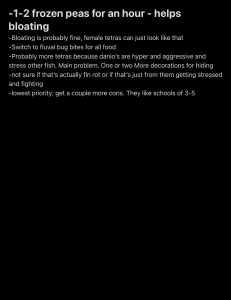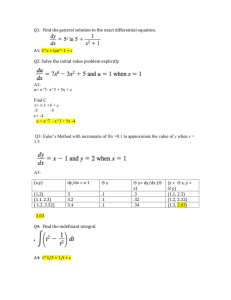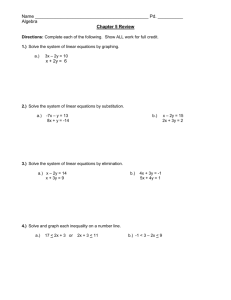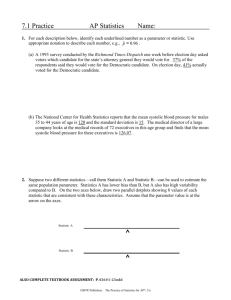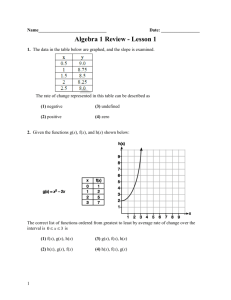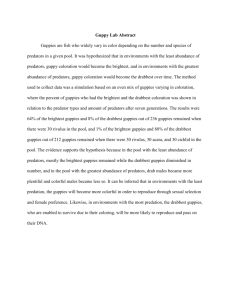AU10 - Lesson 9
advertisement
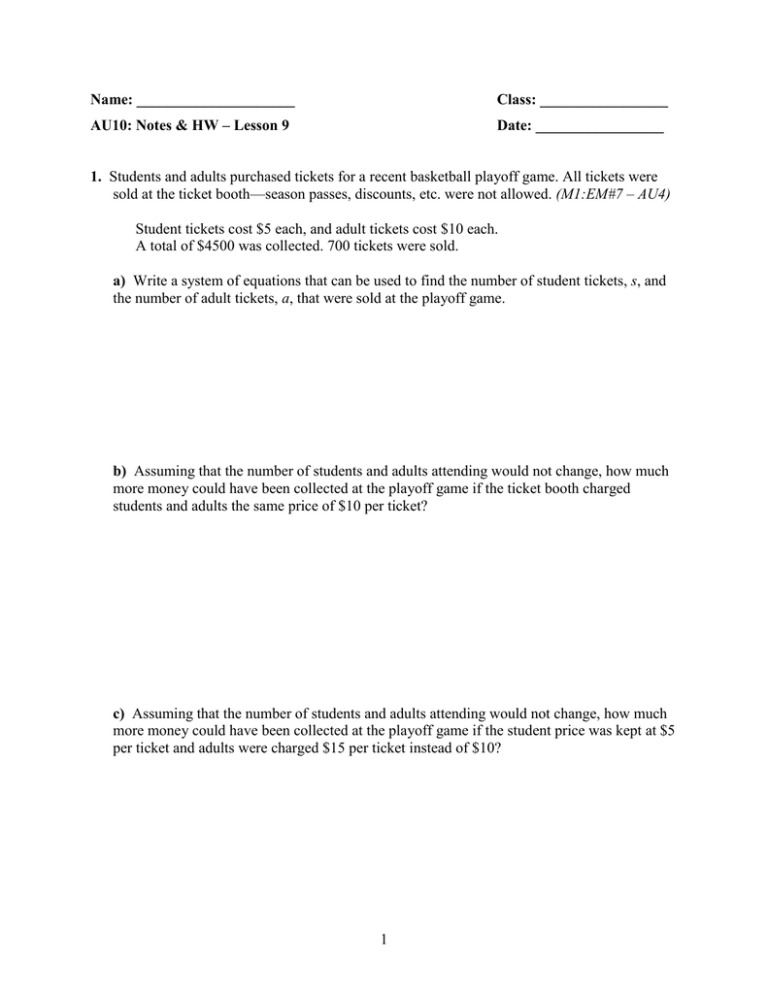
Name: _____________________ Class: _________________ AU10: Notes & HW – Lesson 9 Date: _________________ 1. Students and adults purchased tickets for a recent basketball playoff game. All tickets were sold at the ticket booth—season passes, discounts, etc. were not allowed. (M1:EM#7 – AU4) Student tickets cost $5 each, and adult tickets cost $10 each. A total of $4500 was collected. 700 tickets were sold. a) Write a system of equations that can be used to find the number of student tickets, s, and the number of adult tickets, a, that were sold at the playoff game. b) Assuming that the number of students and adults attending would not change, how much more money could have been collected at the playoff game if the ticket booth charged students and adults the same price of $10 per ticket? c) Assuming that the number of students and adults attending would not change, how much more money could have been collected at the playoff game if the student price was kept at $5 per ticket and adults were charged $15 per ticket instead of $10? 1 2. Weather data were recorded for a sample of 25 American cities in one year. Variables measured included January high temperature (in degrees Fahrenheit), January low temperature, annual precipitation (in inches), and annual snow accumulation. The relationships for three pairs of variables are shown in the graphs below (Jan Low Temperature – Graph A; Precipitation – Graph B; Annual Snow Accumulation – Graph C). a. Which pair of variables will have a correlation coefficient closest to 0? (M2:EM#4 – AU5) A. Jan high temperature and Jan low temperature B. Jan high temperature and Precipitation C. Jan high temperature and Snow accumulation Explain your choice: b. Which of the above scatterplots would be best described as a strong nonlinear relationship? Explain your choice: 2 3. Given hx x 2 3 and g x x 4 . a. Describe how to obtain the graph of g from the graph of ax x using transformations. b. Describe how to obtain the graph of h from the graph of ax x using transformations. c. Sketch the graphs of hx and g x on the same coordinate plane. (M3:EM#1 – AU2/4) y 8 7 6 5 4 3 2 1 –8 –7 –6 –5 –4 –3 –2 –1 –1 1 2 3 4 5 6 7 8 x –2 –3 –4 –5 –6 –7 –8 d. Use your graphs to estimate the solutions to the equation: x 2 3 x 4 Explain how you got your answer. e. Were your estimations you made in part (d) correct? If yes, explain how you know. If not explain why not. 3 4. A boy bought 6 guppies at the beginning of the month. One month later the number of guppies in his tank had doubled. His guppy population continued to grow in this same manner. His sister bought some tetras at the same time. The table below shows the number of tetras, t, after n months have passed since they bought the fish. (M3:EM#3 – AU3/6*) a. Create a function g to model the growth of the boy’s guppy population, where g(n) is the number of guppies at the beginning of each month, and n is the number of months that have passed since he bought the 6 guppies. What is a reasonable domain for g in this situation? b. How many guppies will there be one year after he bought the 6 guppies? c. Create an equation that could be solved to determine how many months after he bought the guppies there will be 100 guppies. d. Use graphs or tables to approximate a solution to the equation from part (c). Explain how you arrived at your estimate. y x 4 e. Create a function, t, to model the growth of the sister’s tetra population, where t(n) is the number of tetras after n months have passed since she bought the tetras. f. Compare the growth of the sister’s tetra population to the growth of the guppy population. Include a comparison of the average rate of change for the functions that model each population’s growth over time. g. Use graphs to estimate the number of months that will have passed when the population of guppies and tetras will be the same. y x h. Use graphs or tables to explain why the guppy population will eventually exceed the tetra population even though there were more tetras to start with. i. Write the function g(n) in such a way that the percent increase in the number of fish per month can be identified. Circle or underline the expression representing percent increase in number of fish per month. 5 5. The graph of a piecewise function f is shown to the right. The domain of f is 3 x 3 . a. Create an algebraic representation for f. Assume that the graph of f is composed of straight line segments. (M3:EM#5 – AU2) b. Sketch the graph of y 2 f x and state the domain and range. y 6 5 4 3 2 1 –6 –5 –4 –3 –2 –1 –1 1 –2 –3 –4 –5 –6 c. How does the range of y f x compare to the range of y kf x , where k 1 ? 6 2 3 4 5 6 x d. Sketch the graph of y f 2 x and state the domain and range. y 6 5 4 3 2 1 –6 –5 –4 –3 –2 –1 –1 1 2 3 –2 –3 –4 –5 –6 e. How does the domain of y f x compare to the domain of y f kx , where k 1 ? 7 4 5 6 x 6. An arrow is shot into the air. A function representing the relationship between the number of seconds it is in the air, t, and the height of the arrow in meters, h, is given by: (M4:EM#3 – AU9*) ht 4.9t 2 29.4t 2.5 a. Complete the square for this function. b. What is the maximum height of the arrow? Explain how you know. c. How long does it take the arrow to reach its maximum height? Explain how you know. d. What is the average rate of change for the interval from t = 1 to t = 2 seconds? Compare your answer to the average rate of change for the interval from t = 2 to t = 3 seconds and explain the difference in the context of the problem. 8 e. How long does it take the arrow to hit the ground? Show your work or explain your answer. f. What does the constant term in the original equation tell you about the arrow’s flight? g. What do the coefficients on the second- and first-degree terms in the original equation tell you about the arrow’s flight? 9 (M4:EM#4 – AU7) 7. Rewrite each expression below in expanded (standard) form: a. x 3 2 b. x 2 5 x 3 5 c. Explain why, in these two examples, the coefficients of the linear terms are irrational and why the constants are rational. Factor each expression below by treating it as the difference of squares: e. t 16 d. q 2 8 10 8. Solve the following equations for r. Show your method and work. If no solution is possible, explain how you know. (M4:EM#5 – AU7) a. r 2 12r 18 7 c. r 2 18r 73 9 b. r 2 2r 3 4 11
